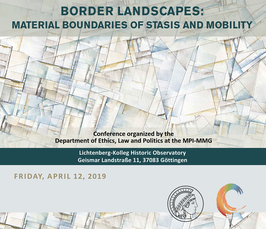"Border Landscapes: Material Boundaries of Stasis and Mobility"
Workshops, conferences 2019
- Datum: 12.04.2019
- Ort: Lichtenberg-Kolleg Historic Observatory, Geismar Landstraße 11, 37083 Göttingen

Please click here to link directly to the event website.
‘Landscape’ occupies a unique position in
the lexicon of spatial concepts. Landscapes represent the interface of the
designed built environment and a milieu of creation beyond that of complete
human control. Through their ambiguous and fluid boundaries, landscapes
hybridize society/nature, human/nonhuman, built/natural binaries and combine
multiple spaces and objects in their evocation of sensory-aesthetic experience.
Furthermore, landscapes serve as a means to enact particular forms of violence and power. The workshop calls attention to the changing shape of a global bordering regime in which the materiality of borders has been weaponized, the ways the heat of desert borders, the vastness of the sea, and the remote location of detention centers have been utilized as constraints on human movement. The shifting spatial configuration of borders complicates the relation between landscapes of ‘inside’ and ‘outside.’ The meticulous fortification of everyday life and the proliferation of borders assemble surveillance technologies, walls, checkpoints, and excision zones while simultaneously establishing zones of abandonment, both territorial and extraterritorial, where violence unfolds through separation, neglect, and disinvestment.
The workshop further explores the methods and strategies of representation by focusing on space, place, scale, and materiality in the study of contemporary border. It reflects on how such methods and strategies contribute to practices of border crossing, transnational solidarity, contestation, and resistance.